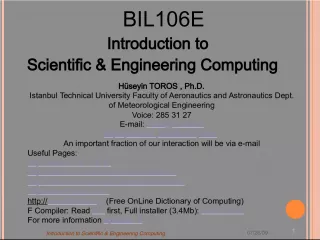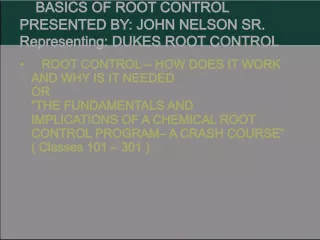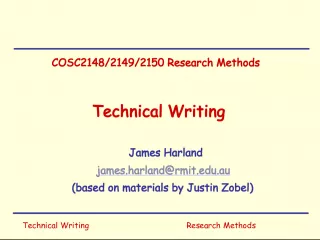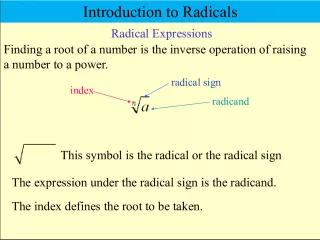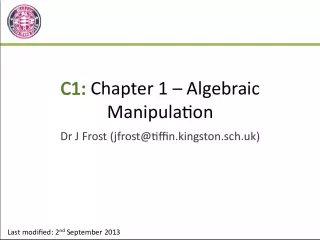Open vs Bracketing Methods for Root Finding in Scientific Computing
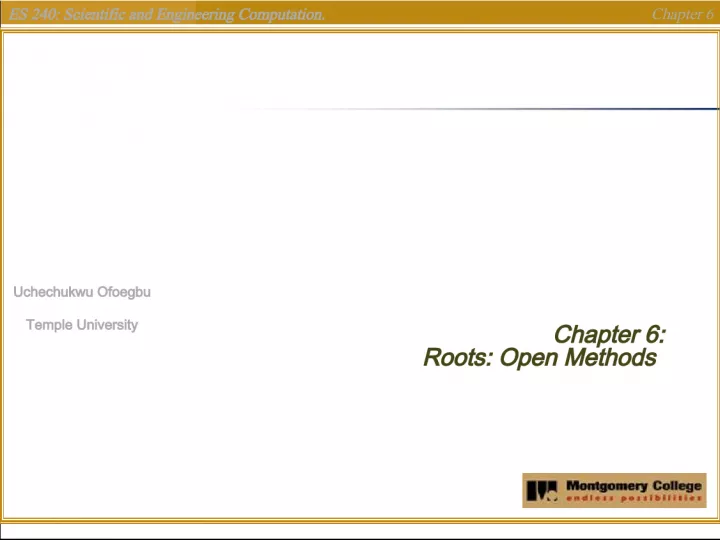

This article compares two types of methods for finding roots in scientific computation - open and bracketing methods. Open methods allow for more flexibility in choosing starting values but may diverge while bracketing methods require the root to be bracketed by two starting values but are more stable.
- Uploaded on | 8 Views
-
 sparco
sparco
About Open vs Bracketing Methods for Root Finding in Scientific Computing
PowerPoint presentation about 'Open vs Bracketing Methods for Root Finding in Scientific Computing'. This presentation describes the topic on This article compares two types of methods for finding roots in scientific computation - open and bracketing methods. Open methods allow for more flexibility in choosing starting values but may diverge while bracketing methods require the root to be bracketed by two starting values but are more stable.. The key topics included in this slideshow are root finding, open methods, bracketing methods, scientific computation, starting values,. Download this presentation absolutely free.
Presentation Transcript
1. ES 240: Scientific and Engineering Computation. Chapter 6 Chapter 6: Roots: Open Methods Uchechukwu Ofoegbu Temple University
2. ES 240: Scientific and Engineering Computation. Chapter 6 Open Methods Open Methods Open methods versus bracketing methods: Open methods require only a single starting value or two starting values that do not necessarily bracket a root. Open methods may diverge as the computation progresses When open methods do converge, they usually do so much faster than bracketing methods.
3. ES 240: Scientific and Engineering Computation. Chapter 6 Graphical Comparison of Methods Graphical Comparison of Methods a) Bracketing method b) Diverging open method c) Converging open method - note speed!
4. ES 240: Scientific and Engineering Computation. Chapter 6 Simple Fixed-Point Iteration Simple Fixed-Point Iteration Rearrange the function f ( x )=0 so that x is on the left-hand side of the equation: x = g ( x ) Use the new function g to predict a new value of x x i +1 = g ( x i ) The approximate error is given by:
5. ES 240: Scientific and Engineering Computation. Chapter 6 Example Example Solve f ( x )= e -x -x Re-write as x = g ( x ) by isolating x (example: x = e -x ) Start with an initial guess (e.g, 0) Continue until some tolerance is reached i x i | a | % | t | % | t | i /| t | i-1 0 0.0000 100.000 1 1.0000 100.000 76.322 0.763 2 0.3679 171.828 35.135 0.460 3 0.6922 46.854 22.050 0.628 4 0.5005 38.309 11.755 0.533
6. ES 240: Scientific and Engineering Computation. Chapter 6 Convergence Convergence Convergence of the simple fixed- point iteration method requires that the derivative of g(x) near the root has a magnitude less than 1. Convergent, | g |<1 Divergent, | g| >1
7. ES 240: Scientific and Engineering Computation. Chapter 6 Newton-Raphson Method Newton-Raphson Method Based on forming the tangent line to the f ( x ) curve at some guess x , then following the tangent line to where it crosses the x -axis. It converges very fast for most functions
8. ES 240: Scientific and Engineering Computation. Chapter 6 Newton-Raphson Method - Example Newton-Raphson Method - Example Use the Newton-Raphson Method to find the root(s) of the function: Find the derivative Use the newt-raph function
9. ES 240: Scientific and Engineering Computation. Chapter 6 Secant Methods Secant Methods Problem with the Newton-Raphson method You have to evaluate the derivative there are certain functions whose derivatives may be difficult or inconvenient to evaluate. Solution Approximate the derivative using the backward finite divided difference:
10. ES 240: Scientific and Engineering Computation. Chapter 6 Secant Methods (cont) Secant Methods (cont) Substitution of this approximation for the derivative to the Newton-Raphson method equation gives: Note - this method requires two initial estimates of x but does not require an analytical expression of the derivative.
11. ES 240: Scientific and Engineering Computation. Chapter 6 MATLABs fzero Function MATLABs fzero Function MATLABs fzero provides the best qualities of both bracketing methods and open methods. Using an initial guess: x = fzero( function , x0 ) [ x , fx ] = fzero( function , x0 ) function is the name of the function being evaluated x0 is the initial guess x is the location of the root fx is the function evaluated at that root Using an initial bracket: x = fzero( function , [ x0 x1 ]) [ x , fx ] = fzero( function , [ x0 x1 ]) As above, except x0 and x1 are guesses that must bracket a sign change
12. ES 240: Scientific and Engineering Computation. Chapter 6 fzero Options fzero Options Options may be passed to fzero as a third input argument - the options are a data structure created by the optimset command options = optimset( par 1 , val 1 , par 2 , val 2 ,) par n is the name of the parameter to be set val n is the value to which to set that parameter The parameters commonly used with fzero are: display : when set to iter displays a detailed record of all the iterations tolx: A positive scalar that sets a termination tolerance on x.
13. ES 240: Scientific and Engineering Computation. Chapter 6 fzero Example fzero Example Use fzero to find roots of f ( x )= x 10 -1 starting with an initial guess of x =0.5. You could also set the options to display iterations: options = optimset(display, iter); Sets options to display each iteration of root finding process [ x, fx] = fzero(@(x) x^10-1, 0.5, options) Uses fzero to find roots of f ( x )= x 10 -1 starting with an initial guess of x =0.5. MATLAB reports x=1, fx=0 after 35 function counts
14. ES 240: Scientific and Engineering Computation. Chapter 6 Polynomials Polynomials MATLAB has a built in program called roots to determine all the roots of a polynomial - including imaginary and complex ones. x = roots(c) x is a column vector containing the roots c is a row vector containing the polynomial coefficients Example: Find the roots of f ( x )= x 5 -3.5 x 4 +2.75 x 3 +2.125 x 2 -3.875 x +1.25 x = roots([1 -3.5 2.75 2.125 -3.875 1.25])
15. ES 240: Scientific and Engineering Computation. Chapter 6 Polynomials (cont) Polynomials (cont) MATLABs poly function can be used to determine polynomial coefficients if roots are given: b = poly([0.5 -1]) Finds f ( x ) where f ( x ) =0 for x =0.5 and x =-1 MATLAB reports b = [1.000 0.5000 -0.5000] This corresponds to f ( x )= x 2 +0.5 x -0.5 MATLABs polyval function can evaluate a polynomial at one or more points: a = [1 -3.5 2.75 2.125 -3.875 1.25]; If used as coefficients of a polynomial, this corresponds to f ( x )= x 5 - 3.5 x 4 +2.75 x 3 +2.125 x 2 -3.875 x +1.25 polyval(a, 1) This calculates f (1), which MATLAB reports as -0.2500
16. ES 240: Scientific and Engineering Computation. Chapter 6 Lab Lab Ex 6.4 a&b Do this step by step in Matlab
